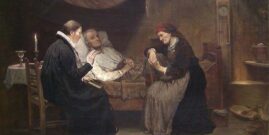Leo Tolstoy's Death of Ivan Ilyich offers perspective on Canada's euthanasia regime.
Three Lanes on an Earthbound Road
Those of us who have laid loved ones to earthly rest have great respect for Three Roads Back by Robert D. Richardson. The author uses the death of family members as the impetus for the book’s subtitle, How Emerson, Thoreau, and William James Responded to the Greatest Losses of Their Lives.
The distinctive nature of Richardson’s thoughtful deliberation, what he calls “documentary biography,” begins under a shroud, the death of kin. Each famed American thinker has their views of life fashioned by its passing. Richardson shows that the inception of American resolve, what he calls “resilience,” is born in the cemetery. The author is keenly aware of his own impending demise during the writing of his book, noted in the foreword by Megan Marshall, and is sympathetic to his subjects’ perspectives. Using long literary cuts from personal letters and famous treatises, Emerson, Thoreau, and William James are allowed their own voice to display the inception of their seminal ideas.
In his preface, Richardson establishes the earthbound views of these three American thinkers. Emerson focused on trusting oneself. Thoreau found Nature to be his touchstone, replacing all other idols, including religion. William James leaned into individual human experiences to authenticate and then authorize all assumptions. Richardson then gives the reader the lens through which to confirm beliefs. “What you give your attention to is the key to what you believe. Whoever or whatever commands your attention also controls what you believe.”
Richardson is positing what educators refer to as affective objectives. Intrinsic, internal controls, created and confirmed by our volitional will are what form our inherent motivations and intentions. The human species tends to easily identify cognitive and behavioral directives; what one knows and what one does. But with effective constraints, the author gets to the heart of the human heart; as Woody Allen so eloquently concluded, “The heart wants what the heart wants.” We are creatures that develop our living by our being, which is shaped by, in Richardson’s view, intimate and personal influences. And for Richardson, the personal influence most important for the thinking of Emerson, Thoreau, and William James, is death.
Emerson, Thoreau, and William James leave us to ourselves and by ourselves. There is no ultimate issuance of order, permanence, or hope whereby a person can find both solace and sustenance for daily life.
Emerson’s wife died sixteen months after they were married. By his own account, he was “unstrung, debilitated by grief.” A minister in “traditional Christianity,” he left the faith a year later. Interestingly, Richardson adds, “He still had, and would always have a religious nature.” The curiosity of the author’s remark is found in the fact that Emerson exchanged Christianity for science, which became Emerson’s new faith. In another Richardson aside, Emerson “is now committed to the truth as he sees it.” Hoping that he could maintain social connections while giving up Christian theology, Emerson’s attitude hints at a broader assertion. All sociological truth claims come from theological truth frames, no matter whether the origin is the Church or the laboratory. The theological need is soon met through transcendentalism in the writings of Thomas Carlyle. “A Divine Idea pervading the visible universe” gives some acknowledgment of external control but ultimately leads Emerson back to himself in his “combat against fate.” Trusting himself, Emerson says, “Know then that the world exists for you” allowing each person to build their “own world.” Any hope to reconcile life with death is left with Emerson’s celebration of “the majestic beauty of the laws of decay.”
The death of Emerson’s son intersected with the death of Thoreau’s brother; experiencing separate incidents but sharing grief during their personal friendship, Emerson and Thoreau consoled each other. Those who have buried family members know of what Emerson writes when he says, “Consolation, none that arises out of the fact itself: only diversion: only oblivion of this, and pursuit of new objects.” In Thoreau’s house, “there was silence and a terrible inactivity.” Richardson adds that Thoreau felt “displaced” and “unsure even of his unsureness.” But it is death that leads Thoreau to life, finding in nature his capstone belief in “the two forces,” decay in winter and rejuvenation in spring. Thoreau’s view “goes beyond the anthropocentric to an ecocentric or nature-centered vision.” Here the ancient agricultural cycles are refashioned; a cyclical view of history making the present, constant. There is no culmination in Thoreau’s earthbound understanding; it is naturalism in its purest form. As Richardson summarizes, for Thoreau, “There is no death … a powerful force for individual resilience … something held in common with all other people and all other forms of life and derives its power from the very fact that it is common.” If there is solace in death, if any hope, it is that all die. Any purpose in life is for now, for us, as the seasons change. For Thoreau, one’s life is one more twig in the fire, crackling till spent, a flash of light, snuffed out, reduced to ash. True to his commitment, Thoreau finds both revelation and redemption in a circuitous life-and-death cycle.
Richardson’s use of death in the lives of American thinkers continues as William James confronts the death of his young cousin, Minny Temple. It is important to know her name and her influence on James’ life. William’s brother Henry, another of Minny’s many admirers, writes, “A very fair portion of my sense of the reach and quality and capacity of human nature rested upon my experience of [Minny’s] character.” And what was Minny’s influence? In a letter to a different friend, Minny writes, “It seems to me, after all, that what comfort we get in religion, and what light we have upon it, come to us through feeling, that is through trusting our feelings, our instinct, as the voice of God.”
So important is Minny’s thinking, that Richardson includes a long cutting from one of her letters to William where she decides against Christianity, and declares that happiness comes from feeling, that salvation is by one’s own effort, and that true life is to be solved by each individual. Borrowing heavily from Minny’s thinking, William James has a “second birth” whereupon his “central insight” is that what is real and good is “the self-governing resistance of the ego to the world.” Any “salvation” is found amidst “fate,” reconciled by reliance “on our own hearts alone.” Ultimately, William James’ philosophy would lead psychology to enshrine the psychological filter of “cognitive behavioral therapy” offering resilience to the afflicted. Any change in life is to be self-directed based on the power of personal experience.
It is the “Horror of the shade,” our inevitable end, that Richardson uses as the essence of human resilience. The line originates from the famed poem “Invictus” where William Henley intones, “I am the master of my fate, the captain of my soul.” It is in the postscript that the reader discovers Richardson’s assumption, his belief, that “resilience is built into us and into things” and “is in truth a universal law or force, discernable anywhere one looks.” Any calamity, including death, reveals “the deep remedial force that underlies all facts.” Allowing Emerson the last word from his book Representative Men, Richardson strains to apply the compelling force which he sees as embedded in nature. Mirroring Emerson’s last line on the final page, “the march of civilization is a train of felonies, yet, general ends are somehow answered,” Richardson’s interpretation provides his final line, “There is a lot of resilience hidden in that word ‘somehow.‘” The reader is left to intuit on her own the origins and ends of any kind of morality, or the good that comes from anything. In our death throes, we cling to faith in self (the ultimate definition of “resilience”) and repeat with Henley, “Under the bludgeonings of chance / My head is bloody, but unbowed.”
Three Roads Back is marked with the signposts: “self,” “nature,” and “experience.” Transient and temporal ideals pervade Richardson’s pages. Emerson, Thoreau, and William James leave us to ourselves and by ourselves. There is no ultimate issuance of order, permanence, or hope whereby a person can find both solace and sustenance for daily life. Resilience, as Richardson envisions, has no ultimate origin beyond impersonal chance.
An unconsidered fourth road forward necessitates a transcendent source of meaning, a reason to go on, no matter the earthly impediments. Humanity yearns for an immovable anchor, something, or Someone, that gives coherence to the world no matter what awfulness is encountered. The fourth road sees death not as some interpretive lens whereby resilience is made, but as the final enemy to be overcome. The fourth road can be just as formative as the other three, still full of agonies and tears. Yet it is on this distinctive path where the resilient person emerges not from a self-made creation, but instead from trust in a Personal God whose jurisdiction is over this life and the one to come. The fourth road is unique because the other three are simply parallel paths in the same direction, all earthbound. But for the pilgrim on the fourth road, who has also stared death in the face, who has also been personally influenced by another’s end of life, the response is not to look down to the grave, but up to Heaven.
My son, Tyler Micah, died at the age of thirty-eight on June 16th, 2022, after battling paranoid schizophrenia for over two decades. He fought and fought until he could fight no more. He and I were the closest of friends as son and father. His whole family gave and gave, aiding and comforting in every possible way. Our loving efforts were always greeted with Tyler’s great gratitude. I take one of his many writings, in the spirit of Richardson’s “documentary biography,” to portray the fourth road. Tyler did not find his resilience in himself. Indeed, he spurned it. In his unpublished poem “When the slightest wink means the subtlest nod,” Tyler wrote:
My eyes have seen the glory of the Lord
in the midnight light of the moon,
in shafts of sun’s light through distant clouds,
blanketing the prairies in light and shadow,
watching motes of dust in the afternoon light of a window,
seeking out the smile of a friend, seeking and finding,
looking at that smile with awe and admiration
because it is altogether new, though I know it so well.
My eyes have seen the glory of the Lord,
wept in time to the dancing waves of His light,
and I am ready for rest to meet that light
in the all- and ever-light of His, my repose.
My hope, Tyler’s hope, my resilience, Tyler’s resilience, is not in the here and now but in the there and then. We are on that fourth road. “The glory of the Lord” is the Hebraic-Christian ultimate, He who is both the origin and end of all things. We are not earthbound but heavenbound. Tyler has arrived at our final destination. He awaits his loved ones there.



